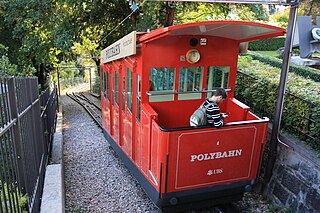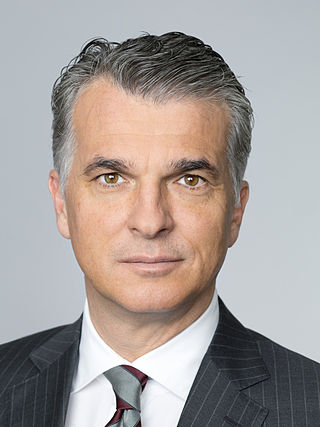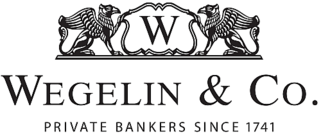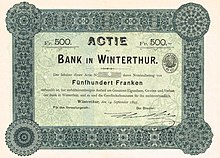
Union Bank of Switzerland (UBS) was a Swiss investment bank and financial services company located in Switzerland. The bank, which at the time was the second largest bank in Switzerland, merged with Swiss Bank Corporation in 1998 to become UBS. This merger formed what was then the largest bank in Europe and the second largest bank in the world.

Banking in Switzerland dates to the early 18th century through Switzerland's merchant trade and has, over the centuries, grown into a complex, regulated, and international industry. Banking is seen as emblematic of Switzerland. The country has a long history of banking secrecy and client confidentiality reaching back to the early 1700s. Starting as a way to protect wealthy European banking interests, Swiss banking secrecy was codified in 1934 with the passage of a landmark federal law, the Federal Act on Banks and Savings Banks. These laws, which were used to protect assets of persons being persecuted by Nazi authorities, have also been used by people and institutions seeking to illegally evade taxes, hide assets, or generally commit financial crime.
Swiss Bank Corporation was a Swiss investment bank and financial services company located in Switzerland. Prior to its merger, the bank was the third largest in Switzerland, with over CHF 300 billion of assets and CHF 11.7 billion of equity.

Credit Suisse Group AG is a global investment bank and financial services firm founded and based in Switzerland. Headquartered in Zürich, it maintains offices in all major financial centers around the world and provides services in investment banking, private banking, asset management, and shared services. It is known for strict bank–client confidentiality and banking secrecy. The Financial Stability Board considers it to be a global systemically important bank. Credit Suisse is also a primary dealer and Forex counterparty of the Federal Reserve in the United States.
Marcel Louis Ospel was a Swiss banker and the longtime head of the multinational investment bank UBS.

The Swiss National Bank is the central bank of Switzerland, responsible for the nation's monetary policy and the sole issuer of Swiss franc banknotes. The primary goal of its mandate is to ensure price stability, while taking economic developments into consideration.

The Swiss Life Group is the largest life insurance company of Switzerland and one of Europe’s leading comprehensive life and pensions and financial services providers, with approximately CHF 255.7 bn of assets under management. Founded in 1857 in Zurich as the Schweizerische Lebensversicherungs und Rentenanstalt cooperative, the company entered the Swiss stock market in 1997 and adopted its current name in 2002. In 2023 the group declared an adjusted profit from operations of CHF 1.50 billion, a 1% increase compared to the previous year. Net profit increased by 8% to CHF 1.11 billion. Swiss Life is one of the twenty companies listed under the Swiss Market Index, as SLHN.

The Polybahn, also known as the UBS Polybahn, is a funicular railway in the city of Zürich, Switzerland. The line links the Central square with the terrace by the main building of ETH Zürich, which was formerly called Eidgenössisches Polytechnikum, and from which the railway derives its name. Previous names for the line include the SBG Polybahn and the Zürichbergbahn. The line is owned by the banking group UBS AG, and operated on their behalf by the municipal transport operator Verkehrsbetriebe Zürich.
Dillon, Read & Co. was an investment bank based in New York City. In 1991, it was acquired by Barings Bank and, in 1997, it was acquired by Swiss Bank Corporation, which was in turn acquired by UBS in 1998.

Ulrich Körner is a German-Swiss businessman. In March 2021, he was named CEO Asset Management of Credit Suisse until July 2022, when he was appointed CEO of Credit Suisse AG.

The Swiss Central Railway was one of the five major private railway companies of Switzerland. The SCB with a track length of 332 kilometres was integrated into the Swiss Federal Railways (SBB) in 1902.

The Swiss Northeastern Railway was an early railway company in Switzerland. It also operated shipping on Lake Constance (Bodensee) and Lake Zürich. Until the merger of the Western Swiss Railways into the Jura–Simplon Railway (JS) in 1890/91, it was the largest Swiss railway company.

The United Swiss Railways was a former railway company in Switzerland. It was the smallest of the five main railways that were nationalised from 1902 to form the Swiss Federal Railways.

UBS Group AG is a multinational investment bank and financial services company founded and based in Switzerland. Headquartered in Zürich, it maintains a presence in all major financial centres as the largest Swiss banking institution and the largest private bank in the world. UBS client services are known for their strict bank–client confidentiality and culture of banking secrecy. Because of the bank's large positions in the Americas, EMEA and Asia Pacific markets, the Financial Stability Board considers it a global systemically important bank.

Toggenburger Bank is one of the original predecessor banks to the Union Bank of Switzerland and ultimately UBS. Established in 1863, the bank merged with the Bank in Winterthur in 1912 to form the Union Bank of Switzerland.
Dr. Rudolf Ernst of Winterthur was a Swiss Industrial, Insurance, Banking Pioneer and founding father of UBS. He was also the first CEO and Chairman of the Board of Directors of the Union Bank of Switzerland, now UBS. Following his retirement, at age 77, he was elected Honorary Chairman of the Union Bank of Switzerland for life, but remained on the Board of Directors until 1953, when he retired at age 87.<SBG/UBS Commemorative Book 1862 1912 1962>

Sergio Pietro Ermotti is a Swiss manager and investment banker. In April 2021, Ermotti was elected Chairman of Swiss Re, one of the world's largest reinsurance companies, succeeding Walter Kielholz. He was the Group Chief Executive Officer (CEO) of UBS Group AG from November 2011 to October 2020 and regained that position in 2023. He is also a board member of the Institute of International Finance.

Wegelin & Co. is a former private bank that was located in St. Gallen in the Canton of St. Gallen in Switzerland, and specialized in private banking and asset management.

Raiffeisen Switzerland is a cooperative of cooperatives – the union of all independent Swiss Raiffeisen banks. It bears responsibility for the business policy and strategy within the Raiffeisen Group. The 219 independent Raiffeisen banks of Switzerland are organised as cooperatives. With 896 branch offices in total, they make up the densest branch network of any Swiss bank. After the acquisition of Credit Suisse by UBS, the Raiffeisen Group has become the second-largest banking group in Switzerland with client assets under management of 246.6 billion francs. Since June 2014, Raiffeisen has been classified as one of Switzerland's systemically important banks and must therefore meet special requirements in terms of capital. Raiffeisen Switzerland has 3.65 million clients in Switzerland, of whom approximately 1.9 million are cooperative members and thus co-owners of their regional Raiffeisen banks.
Hyposwiss Private Bank Ltd was a Swiss private bank, located in Zurich, that closed in 2013.

















